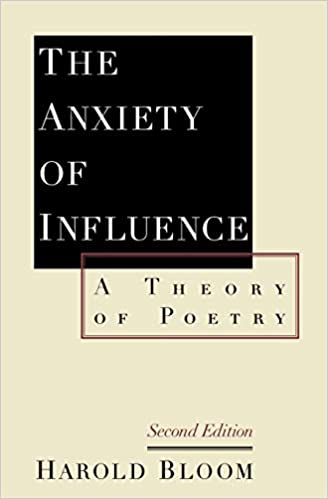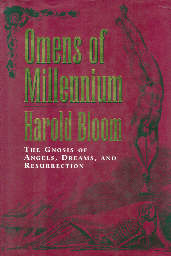by Harold Bloom
Review by Dan Geddes
5 October 1999
See other reviews of Bloom:
The Book of J,
Omens of Millennium,
The Western Canon.
After a generation characterized by psycho-criticism and the New Criticism, Harold Bloom’s The Anxiety of Influence must have come to its first readers as a balm. Bloom argues that new poems originate mainly from old poems; that the primary struggle of the young poet is against the old masters. He, the ephebe, must “clear imaginative space” (1) for himself through a creative misreading of the strong poets of the past. Only strong poets can overcome this anxiety of influence; lesser lights become derivative flatterers and never achieve poetic immortality for themselves.
The idea of poetic influence is nothing new, and Bloom even traces the idea of “influence” for us: its origins as divine afflatus (the influence of the stars); its metamorphosis into moral effects on others, down to its more contemporary idea: that poets are decisively influenced by a handful of masterful forebears whose signatures can often be seen in the works of the later poet. But Bloom is offering us something deeper than what he terms reductionist “source-study,” “the history of ideas,” or “the patterning of images.” The struggle between the young poet (the “ephebe,” the “citizen of poetry” as ancient Athenians termed him) and his great precursors is more of a psychological agon, where the young poet’s only weapon against the greats is creative misprision. A successful misreading of past works allows the ephebe room for his own voice to be heard–and if spectacularly successful, he can come dwarf even the precursor, to make us read the precursor in terms of the later poet, rather than vice versa.
Bloom’s scholarly range cursorily covers the last 500 years of Western poetry, showing a genealogy of giants starting from Shakespeare (purposely untreated in the study), who begat Milton, who begat Wordsworth, who begat Shelley and Keats, who begat Browning, who begat Yeats. A similar American line (Emerson to Stevens) is also treated, with tangential reference to figures as diverse as Pindar, Homer, Virgil, Dante, Goethe, Rilke, and many others. Bloom excels at provocative statements (i.e., “for in him [Rilke] the revisionary ration of daemonization was stronger than an any other poet of our century”), which are often left unsupported. The reader is swept away by the breadth and esotericism of Professor Bloom’s narrative. He is apparently intimate with the entire Western canon, as he freely attests in a later work by that name.
In lieu of thorough treatment of specific cases of the anxiety of influence, the bulk of the work covers the six methods of poetic misprision. These are summarized in the introduction, with a chapter devoted to each.
It should first be noted that the six ratios of misprision may or may not represent developmental stages of the ephebe. Bloom suggests (but never seems to state outright) that younger ephebes are more likely to use the first few strategies, while strong poets may use the latter ones in the final works. Such a developmental outline of poetic misprision would be too unwieldy a thesis for all the complexities of the anxiety of influence especially as a theory of poetry for all poets.
The Six Revisionary Ratios
- Clinamen, “poetic misreading or misprision proper.” A “swerve” away from the precursor; a corrective movement in the later poem, with all the implication that the precursor was correct up to a point, but that he, the ephebe, has made the right turn in his new poem.
- Tessera, “completion and antithesis.” (Tessera is still used for mosaic-making.) Bloom claims to use it more in the sense of the ancient mystery cults, who could, for example, reconstitute a piece of pottery from a mere fragment of it. It is antithetical because it implies that the precursor did not go far enough–despite the ephebe’s retention of the precursor’s terms and perhaps worldview.
- Kenosis “is a breaking device similar to the defense mechanisms our psyches employ against repetition compulsions; kenosis then is a movement toward discontinuity with the precursor.” From St. Paul, who uses the term in regard to Jesus’ empties the divine out of himself to assume human form. Similarly the poet empties out the poetic afflatus of the precursor. The precursor too is emptied out.
- Daemonization (or the Counter-Sublime) is an achievement of a new sublime via the ephebe’s own daemonization. The ephebe taps into a daemonic power that informed the precursor poet, and hence the ephebe is inspired by a power to superior to the precursor. Hence the uniqueness or originality of the precursor is “explained away,” or the ephebe achieves ease through the belief that he has tapped into a source equal to or greater than the precursor.
- Askesis, “or a movement of self-purgation,” an achievement of solitude. The ephebe’s revisionary movement “curtails” both his own and the precursor’s achievement, fundamentally a cleansing of influence, and a general avowal of independent achievement.
- Apophrades, “or the return of the dead.” Taken from “the word from which the Athenian dismal or unlucky days upon which the dead returned to re-inhabit the houses in which they had lived.” The later poet is burdened by his own achieved solipsism, and so he makes the conscious effort of holding his own poem open to that of the precursor. But the fact that the later strong poet consciously engages the work of the precursor, rather than is helplessly influenced by it, shows the strength of the later poet, and even creates the “uncanny effect” that later poet seemed to have written the precursor’s work, rather than vice versa. We now (in the rare cases that the later poet has overpowered the precursor) see the precursor’s work in terms of the later poet.
Although a far cry from the psycho-criticism, which seeks to understand poetry in terms of the entire psychic life, relying on biography and (perhaps the worst excesses of) Freudianism, the anxiety of influence attempts to explain the development of the poet qua poet. In explaining poetic influence Bloom offers almost no biographical details. And yet the anxiety of influence is a psychological explanation of a sort, and employs Freudian terminology. The relationship between precursors and their poetic “sons” is likened to a Freudian “family romance,” where poetic relations seem to bear familial resemblances to one another.
Equally, poetic influence, if it is not to overpower the ephebe, must be “sublimated” into a various forms. Conscious admission of the precursors’ influence can be the death-knell for the ephebe’s own self-confidence as a unique and unprecedented creator. The kenosis ratio, for example, is explicitly compared to the defenses the psyche employs against repetition compulsions, as if the overarching power of the precursor becomes a haunting idée fixe for the ephebe. Anxiety itself, as Bloom tells us, was conceived by Freud as angst vor etwas, “fear before something,” which for Bloom’s theory explicates how the poet is directly fearful of the precursor’s influence.
In addition to Freud, the other great influence on Bloom’s theory is Nietzsche, whom Bloom calls the “prophet of the antithetical.” The early Nietzsche, in The Birth of Tragedy, was concerned with the psychology of the artist, especially in his agonistic and ascetic strains. Bloom speculates that Nietzsche’s concern with the Will reveals something of his own anxiety of influence. Nietzsche, despite being “a great denier of the anxiety of influence,” was probably its most penetrating psychologist.
The first chapter, on clinamen, is probably the best of the six chapters that Bloom devotes to the six revisionary ratios. Clinamen is “misprision proper,” and so elements of it exist in all the more specific ratios. But before treating clinamen specifically, Bloom offers an illustration of the anxiety of influence by a startling interpretation of Paradise Lost. In it, Bloom posits Milton’s Adam and Satan as the archetypal modern poets in various stages of development. Adam represents the ephebe at his state of constriction, while Satan represents the limits of opacity, the border between God and man, as well as solipsism and otherness. Satan is poetic in that he “rallies all that remains,” despite his own descent into hell. Similarly, argues Bloom, the modern poet must rally all that remains in himself, despite the fact that he speaks in the inherited voice of the poetic past.
Despite the grandeur of this illustration, the reader may find such an allegorical interpretation of Milton (even though Bloom makes no assertion that this is Milton’s intention) strained–too general to capture the motivations of centuries of Western poets since. Bloom does offer something of an explanation of why men write poems–“to rally all that remains” after a poetically primal encounter with one’s precursors, but this explanation leaves something to be desired. (Bloom completely ignores, for example, biographical information.) Instead Bloom returns to his charming allegory, wherein Adam represents natural man “beyond which our imaginations will not contract,” and Satan suggests a briefly won supernatural power which can not be maintained. The strong poet’s quest for divinity and immortality (drives which all men have but poets more so) is thwarted by the Covering Cherub, which bars the path back to paradise, i.e., represents the hardness that prevents the poet from his full creative potential (perhaps his shame about the sin of influence).
Indeed the Covering Cherub can be so strong as to completely strangle certain ephebes, who are condemned by their weakness to become essentially critics: i.e., Samuel Johnson, Walter Pater, T.S. Eliot, and no doubt Bloom himself. Poetic influence is essentially a disease of self-consciousness, and only the strong poet can overcome such compunctions to make his quest for immortality despite the personal risks.
Poetic influence, as Bloom tells us, is “a destruction of desire.” Although not elaborating upon it, the suggestion is that the grandeur of the precursor instills doubt and self-consciousness in the ephebe, who now cannot realize his own creative vision. The Covering Cherub, as symbol of the anxiety of the influence, also represents continuity with the past (a facet of the Cartesian worldview), wherein the poet cannot carve out his own imaginative space; cannot see the future as of yet undetermined; cannot create his own universe (“as Blake did”). He is condemned to receive a predetermined nature, to respond to it as did the poets of the “ruminative line” rather than to smash the subject/object dichotomy and linear time restrictions as the poets of the prophetic line do with varied success.
The Anxiety of Influence owes much of its power to Bloom’s insight into the psychology of the poet. Poetic influence has usually been seen as in a beneficent light, and not the potential source of anguish that Bloom describes. Bloom’s theory is a welcome antidote to the Freudianism of so many other literary critics, who trace only the childhood traumas of the young poet. Bloom’s focus on poets’ encounters with other poets seems natural considering his own voracious boyhood reading.
The Anxiety of Influence made Bloom’s reputation, and remains respected work even by Bloom’s many detractors.
5 October 1999
See other reviews of Bloom:
The Book of J,
Omens of Millennium,
The Western Canon.
See also Wikipedia










“Bloom’s theory is a welcome antidote to the Freudianism of so many other literary critics, who trace only the childhood traumas of the young poet. ”
Bloom’s theory is completely Freudian, explaining all poetry as the working-out of an Oedipus complex, in which the older poet is a father-figure and must be figuratively killed.